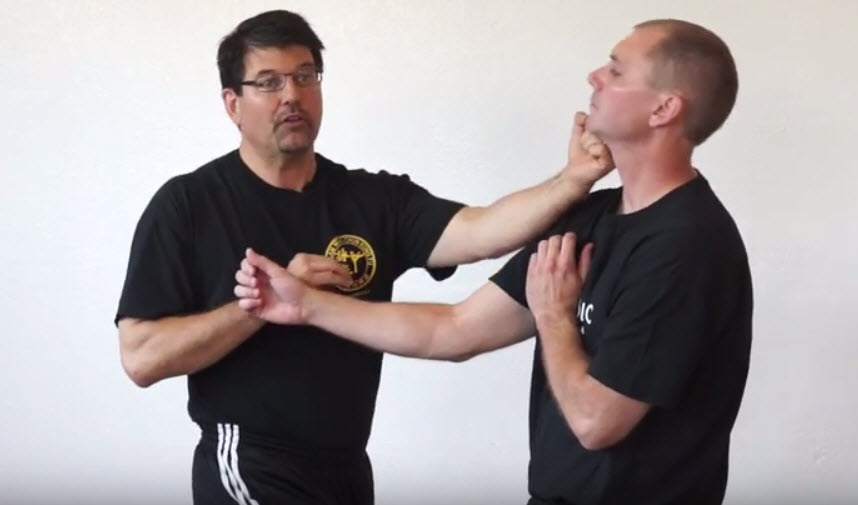
The Hidden Hand in Chain Punching
April 21, 2015
The Bong Sau is the best hand you never want to use.
Wing Chun Songs
The Bong Sau is never seen.
Wing Chun Songs
As you can see, if we listen to the Wing Chun Kuen Kuit (songs), the Bong Sau is something of a “hidden hand” in fighting.
It is another question for another post about whether it should be seen quite so much in training!
But today I would like to draw your attention to another “hidden hand” in the system. The retreating/rechambering hand of the chain punching sequence (aka Lin Wan Kuen).
There are a lot of misconceptions about chain punching. I try to be pluralistic and understanding of the fact that there are many flavors and interpretations of the ideas which drive Wing Chun and how these ideas are expressed in techniques, but sometimes you just have to take a stand and point out when something is WRONG.
Chain punching is not something we do as we walk toward an opponent, each punch fully extended so the arm finishes as a straight line from fist to shoulder (as you sometimes see on Youtube).
Chain punching is not an invincible technique. If someone walks toward you chain punching, you can easily time the punches, evaluate, anticipate, and intercept the angle (with a Jutt or Jaam) and cover (hands on top and push down and forward).
The Wing Chun songs advise putting two hands on top because of the power of leverage. Body weight versus the shoulder muscles holding up that arm is no contest. And the further that arm is extended, the easier it is to cover or deflect. All the power of a punch is spent when the arm is fully extended. There is the potential for what they call “long power” from an extended arm, but its a slight amount of power which is typically directed sideways, not forward.
Basically, before you punch, you must be in range. By “in range,” I mean Wing Chun distance.

Wong Shun Leung called our system the “science of in-fighting.” In-fighting means you get right up in their grill and fight at a distance of about one to one and a half feet, or what we would call “Tan Distance.” This is the arm bent at about a forty-five degree with the elbow a little forward, somewhere between one or two “fists” distance from the body. The arm shape looks like a somewhat flattened “V.”
With this arm shape and from this distance, you can strike someone in the head with an elbow down position and have room for a little extension. This angle, with the elbow in front of the hip, can create what we would call a “grounded” strike. A punch with ground power backing it up.
The arm is not completely extended for the hit. Ideally, in a clean hit, the elbow might move about 6 inches or so. The fist will displace the head and then make way for the next fist in the chain (of what should be two to three strikes, not fifteen).
Our punching is more like a semi-automatic than a machine gun. We don’t “spray and pray.” We make them count. We pick our target.
So we need to move into position, bridging that fairly dangerous two to three foot gap from outside kicking distance in to Wing Chun distance, protecting ourselves with the triangular cage created by our center-facing elbows and slightly extended forearms (bringing our fists closer to the target).
We reach forward until we either get in range or encounter an obstructing arm. Whether its moving in our direction (some sort of strike) or just hanging there, we have about 6 options (in our system) for dealing with that obstruction.
Strike forward with the elbow in and displace the arm and hit the head with the same motion.
Use footwork (angle step). Then hit.
Pull the arm to the a side (Lap or Toi). And hit.
Cover (Jutt). Hit.
Smack out of the way with the minimum force needed to clear the path (Pak or Bong). Hit.
The best action is simultaneous. The second best action is first one then the other.
Get to hitting ASAP!
When I speak of the hidden hand in chain punching, I mean that hand which is on its way back. Its not just preparing for another hit. Its keeping the lane clear. Its acting as a helping hand, as a sort of a Jutt, to cover and occupy that angle of attack.
Don’t even think about it as a hand. You don’t even need “hands” to do Wing Chun.
You need elbows with forearm bones (radius and ulna). The elbow is like a hand holding a knife and the bones are like the blade of the knife.
Imagine stabbing into someone, your elbows like fists, your forearms like blades. A succession of stabs into the opponent. Only its a “V” shaped arm jabbing into the space, followed by another, and then another, each hit solid, loading into the hip into the heel into the ground, driving the opponent back, spearing up into their head at an acute angle, driving their head back.
And each time you hit, on its way home, that hand keeps the lane clear for its brother, coming just behind.